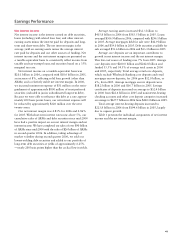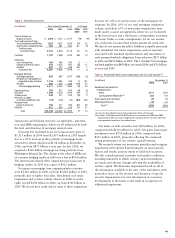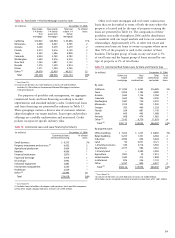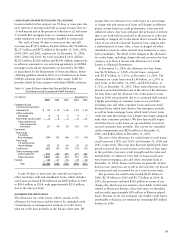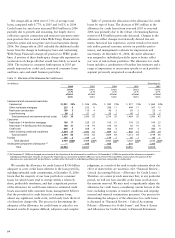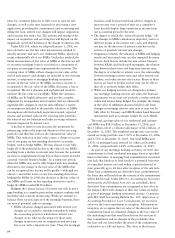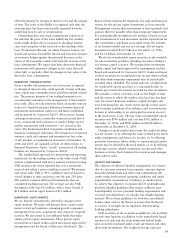Wells Fargo 2006 Annual Report Download - page 50
Download and view the complete annual report
Please find page 50 of the 2006 Wells Fargo annual report below. You can navigate through the pages in the report by either clicking on the pages listed below, or by using the keyword search tool below to find specific information within the annual report.
48
Off-Balance Sheet Arrangements and Aggregate Contractual Obligations
Off-Balance Sheet Arrangements,Variable Interest
Entities, Guarantees and Other Commitments
We consolidate our majority-owned subsidiaries and variable
interest entities in which we are the primary beneficiary.
Generally, we use the equity method of accounting if we own
at least 20% of an entity and we carry the investment at cost
if we own less than 20% of an entity. See Note 1 (Summary
of Significant Accounting Policies) to Financial Statements
for our consolidation policy.
In the ordinary course of business, we engage in financial
transactions that are not recorded in the balance sheet, or
may be recorded in the balance sheet in amounts that are
different than the full contract or notional amount of the
transaction. These transactions are designed to (1) meet the
financial needs of customers, (2) manage our credit, market
or liquidity risks, (3) diversify our funding sources or
(4) optimize capital, and are accounted for in accordance
with U.S. generally accepted accounting principles (GAAP).
Almost all of our off-balance sheet arrangements result
from securitizations. We routinely securitize home mortgage
loans and, from time to time, other financial assets, including
student loans, commercial mortgages and auto receivables.
We normally structure loan securitizations as sales, in accor-
dance with FAS 140. This involves the transfer of financial
assets to certain qualifying special-purpose entities that we
are not required to consolidate. In a securitization, we can
convert the assets into cash earlier than if we held the assets
to maturity. Special-purpose entities used in these types
of securitizations obtain cash to acquire assets by issuing
securities to investors. In a securitization, we record a liabili-
ty related to standard representations and warranties we
make to purchasers and issuers for receivables transferred.
Also, we generally retain the right to service the transferred
receivables and to repurchase those receivables from the
special-purpose entity if the outstanding balance of the
receivable falls to a level where the cost exceeds the benefits
of servicing such receivables.
At December 31, 2006, securitization arrangements
sponsored by the Company consisted of $168 billion in
securitized loan receivables, including $109 billion of home
mortgage loans. At December 31, 2006, the retained servicing
rights and other interests held related to these securitizations
were $1,632 million, consisting of $1,223 million in servicing
assets, $358 million in other interests held and $51 million in
securities. Related to our securitizations, we have committed
to provide up to $33 million in credit enhancements.
We also hold variable interests greater than 20% but less
than 50% in certain special-purpose entities formed to provide
affordable housing and to securitize corporate debt that had
approximately $2.9 billion in total assets at December 31,
2006. We are not required to consolidate these entities. Our
maximum exposure to loss as a result of our involvement with
these unconsolidated variable interest entities was approxi-
mately $980 million at December 31, 2006, predominantly
representing investments in entities formed to invest in
affordable housing. However, we expect to recover our
investment over time primarily through realization of federal
low-income housing tax credits.
For more information on securitizations, including sales
proceeds and cash flows from securitizations, see Note 20
(Securitizations and Variable Interest Entities) to Financial
Statements.
Home Mortgage, in the ordinary course of business, origi-
nates a portion of its mortgage loans through unconsolidated
joint ventures in which we own an interest of 50% or less.
Loans made by these joint ventures are funded by Wells Fargo
Bank, N.A. through an established line of credit and are
subject to specified underwriting criteria. At December 31,
2006, the total assets of these mortgage origination joint
ventures were approximately $90 million. We provide liquidity
to these joint ventures in the form of outstanding lines of
credit and, at December 31, 2006, these liquidity commit-
ments totaled $383 million.
We also hold interests in other unconsolidated joint
ventures formed with unrelated third parties to provide
efficiencies from economies of scale. A third party manages
our real estate lending services joint ventures and provides
customers title, escrow, appraisal and other real estate related
services. Our merchant services joint venture includes credit
card processing and related activities. At December 31, 2006,
total assets of our real estate lending and merchant services
joint ventures were approximately $835 million.
In connection with certain brokerage, asset management,
insurance agency and other acquisitions we have made, the
terms of the acquisition agreements provide for deferred
payments or additional consideration, based on certain
performance targets. At December 31, 2006, the amount
of additional consideration we expected to pay was not
significant to our financial statements.
As a financial services provider, we routinely commit to
extend credit, including loan commitments, standby letters
of credit and financial guarantees. A significant portion of
commitments to extend credit may expire without being
drawn upon. These commitments are subject to the same
credit policies and approval process used for our loans. For
more information, see Note 6 (Loans and Allowance for Credit
Losses) and Note 24 (Guarantees) to Financial Statements.
In our venture capital and capital markets businesses, we
commit to fund equity investments directly to investment
funds and to specific private companies. The timing of future
cash requirements to fund these commitments generally
depends on the related investment cycle, the period over
which privately-held companies are funded by investors and
ultimately sold or taken public. This cycle can vary based on
market conditions and the industry in which the companies
operate. We expect that many of these investments will become
public, or otherwise become liquid, before the balance of
unfunded equity commitments is used. At December 31, 2006,





